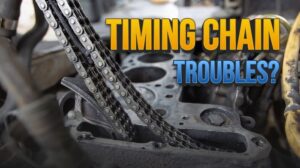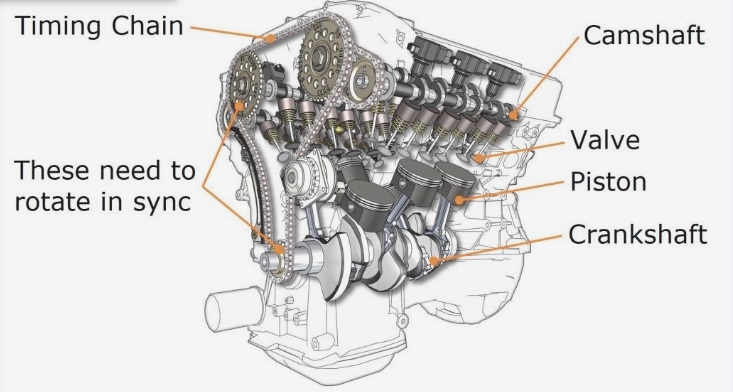The timing chain comes with metal links that move over gears set for the rotation of the crankshaft and camshaft and controls the opening and closing of the engine valve with a combination of firing pistons. The timing chain is connected to the inside of the engine and gets lubrication from engine oil, which helps to provide easy working. In this post, we will cover detailed features and the working of the bad timing chain and learn how to manage it.
What Is a Timing Chain on a Car?
- The timing chain is the main part of the engine that helps to provide the opening and closing of valves in a combustion engine. These valves close and open with a combination of camshaft and crankshaft, and a timing chain also avoids the striking of engine pistons with valves.
- If there is a faulty or bad timing chain, the crank will not provide synchronization of valve opening and closing.
- As a result, combustion does not occur, and the car does not operate.
Types of Timing Chains
- There are different types of timing chains that are explained here.
Link Chains
- This type of timing chain is designed with the use of precision links that are made with alloy steel. that connected with pressed pins. It is also called a silent chain since its design helps to provide smooth working. If you do not have smooth working of the chain, it causes a timing chain problem.
Roller Chains
- This chain is the same as a bicycle chain but has a durable nature. A car that has a small engine capacity comes with a roller chain. A high-power engine needed a double chain. high-power engine uses double chain

Timing Chain Working
- This chain operates continuously on sprockets in a round shape, like a conveyor belt. Its motion is controlled with high accuracy for getting synchronization of opening and closing of valves.
- That also causes wear and tear that can damage the timing chain.
Signs of a Bad Timing Chain
Different signs of a bad timing chain are explained.
Rattling Sound on Engine Starting
- The main error that shows a bad timing chain is the rattling noise produced when the engine is starting or the brakes are applied. It occurs as a result of a loose or stretched timing chain that rattles during rotation in a condition when the engine motor is running.
Misfiring Engine
- • The timing chain manages opening and closing engine valves, so damage can affect the air-fuel ratio and affect power. It causes jerking motion and affects acceleration.
Contamination of Engine Oil
- There are metal bits in the engine oil, with the damaged timing chain component also mixed in the oil. This fault needed to be assessed promptly.
Check Engine Light
- • A bad timing chain also causes the check engine light to glow. That is a sign to access engine errors that can also be the cause of a bad timing chain.
difficult to start the engine
- It means your car’s timing chain is broken. which causes the vehicle not to start and also damages other parts of the engine.
Sputtering
- If there is sputtering at the time of acceleration, that means the timing chain is faulty and affects accuracy. The bad timing changes affect engine timing, which causes the cluster to work.
Causes for a Bad Timing Chain
If we drive a vehicle for a longer time, it needs to be replaced, and different conditions occur that cause a bad timing chain. You must know
not changing engine oil
- Engine oil provides lubrication for the moving parts of the engine. That also lubricates the timing chain and gears.
- If not changed timely, oil causes wear and reduces the working life of the timing chain. Oil gets damaged due to high temperatures to detergents in gasoline. that affect oil lubrication features
- With time, the engine becomes less coated. The timing chain can be unprotected from metal-on-metal damage. that causes a high level of wear
Wrong Engine Oil
- If you use the wrong engine for the car, a different engine will provide the same working but not have the same composition. So use the recommended engine oil for certain car models.
- For oil details, you can read the manual details that are written on the hood of the car. The rating of the engine is set based on weight, which cannot provide accurate details. That is a measurement of viscosity.
- 0W20 moves as thick oil in summer conditions and thick in winter, as compared to 5W20, which flows like 5-weight oil in hot weather and 20-weight oil in the winter.
- If you use oil that is not according to engine features, it can cause the timing chain to be starved of oil and the coating of oil to be thick, which reduces working performance.
- So use the recommended oil for your vehicle.
heavy loads on the vehicle
- If the engine facing high loads causes damage to the timing chain. since high weight causes difficulty for the engine to work and move the vehicle. In case of heavy loads, chain rattling occurs, whichnormally occurs for damaged chains.
Faulty Tensioner
- • The timing chain also causes the tensioner. Its working is to provide tension for keeping the chain taut and avoiding jumping. There are 2 main types of tensioners: hydraulic and spring-loaded.
- If tensioners damage it, it will affect the holding of the timing chain. It can also cause a rattling sound, which also helps the chain to move and badly affects the engine. Due to it backfiring, engine lights get on.

